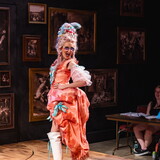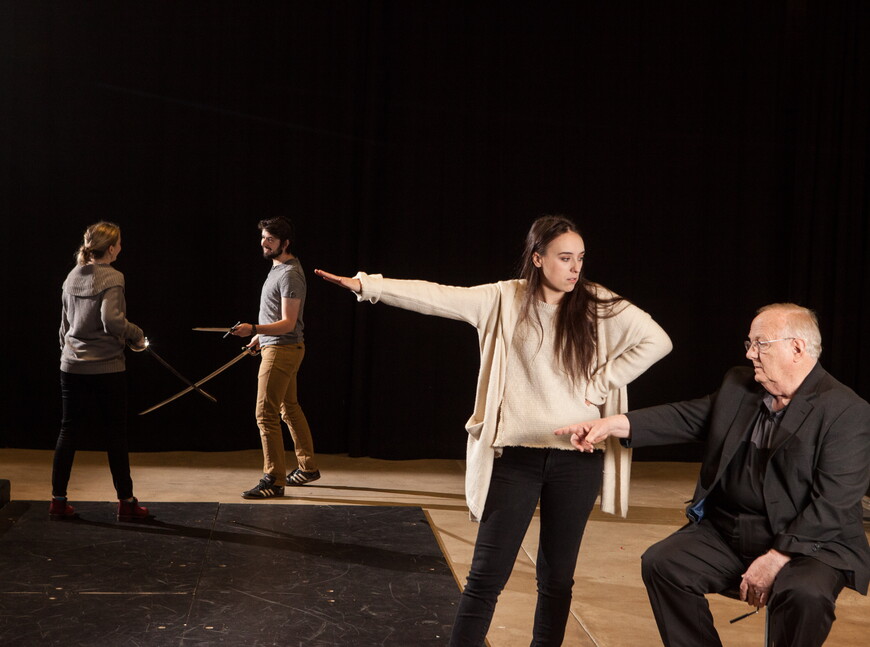Natalia Spengler isn’t interested in likely stories. Give her a tale that twists. Make it vast. Have it kink and kick and contradict. That’s when you know you have something.
You have a story that lands—like Spengler’s own 2,800-mile journey—in an unexpected place. A story that slides, neatly, into the unlikeliest of roles.
***
First, let’s hash out some contradictions.
Yes, when NWU Theatre opens its production of Hamlet on January 17, and Spengler utters her first, contradictory line (calling the new king, “more than kin, and less than kind”), she’ll be a woman playing the part of a man. But that’s probably the least interesting mismatch in her story.
There’s her background. Spengler is American. And Polish. Her dual citizenship meant a childhood of travel. But her unusual worldliness pairs with an unusual isolation. Her home is a capital city, but one accessible only by ferry or seaplane. Juneau, Alaska, is America’s second-largest city by area. Yet its population is just a couple family reunions larger than Kearney’s.
There’s her experience. Spengler hadn’t performed in a single play at her high school. Yet NWU Theatre recruited her out of Juneau with the promise of a wilderness of opportunities to act.
We should stop here and admit that, though true, our saying she never acted at her high school is specious. By 18, Spengler had extensive stage experience and a deep appreciation for Shakespeare. She just didn’t build them at her high school. Juneau’s “Shakespeare-enamored” Theatre in the Rough was her acting home. She’d been both underfoot and onstage at the community theatre since middle school.
You can make a good argument that high schools should teach more Shakespeare. But Spengler is grateful her first exposures came outside the classroom.
“Your first taste of Shakespeare should be as a kid in the audience, watching a good production,” she said, recalling the productions she’d watched as a kid in Alaska, Oregon and Europe. “Good actors help you feel so much more of what’s there than you get just reading a script for class.”
***
Nebraska Wesleyan University’s first exposure to Spengler came in Chicago during the National Unified Auditions. She spoke to Professor of Theatre Jack Parkhurst and Professor of Theatre Joan Korte outside of Unifieds. She impressed them immediately.
“She had this great interest in Shakespeare and a real grasp of the depth of his characters,” Korte said.
Korte and Parkhurst described Nebraska Wesleyan’s commitment to Shakespeare productions and the success of several NWU alumni now working in Shakespeare companies. The two professors quietly hoped the Alaskan was as impressed with NWU as they were with her.
She was.
“The emphasis on Shakespeare was a lot of it,” Spengler said. So was Nebraska Wesleyan’s production volume. “Hardly anybody else in the country comes anywhere near the 40-plus productions we do here.”
After that meeting in Chicago, Spengler committed to visiting campus. “NWU was high on my list, but I had to see it, you know?”
She recalled that day. “I was so sick with some horrible stomach bug.” But when you’ve flown 2,800 miles to see a place, there’s no rain check. She gritted out her tour, hoping to avoid getting sick in the lilacs outside Elder Theatre.
Despite her nausea, Spengler’s strongest gut feeling was that she’d found her next home. Her top-five list shortened by four schools.
Korte and Parkhurst knew they’d landed a special student. So did the Huge-NWU Scholarship selection committee. Spengler won Nebraska Wesleyan’s top academic award, named after Harry and Reba Huge. The scholarship covers the full cost of tuition, fees and room and board.
“It was super-exciting,” Spengler said of winning the award. “And it’s certainly made my going to college a lot easier for my family financially.”
Korte signed Spengler into her junior-level Shakespeare course as a first-year student. “It’s where she belonged,” Korte said. She’d take it again as a sophomore.
And placing Spengler in Professor of English Scott Stanfield’s first-semester Archway Seminar on Hamlet was a no-brainer. Stanfield recalled her research paper: a look at the history of female Hamlets.
Theatrical gender bending is older than Shakespeare. Women weren’t allowed on the London stage in the 16thcentury, meaning every female role in Shakespeare was originally played by a boy or man. Once women were allowed onstage, rules on their dress remained strictly conservative.
“One’s rules of propriety make one thirst for the improper,” wrote the novelist Mohsin Hamid. And the earliest examples of female Hamlets were meant to quench this thirst.
“Hamlet was a ‘tights part,’” Stanfield explained. And by casting a woman in the role, a director could sidestep the rules on costuming, giving 18thcentury audiences something they’d rarely seen on stage before: namely, a woman’s legs.
The first known female Hamlet to be regarded primarily for her acting wouldn’t come until 1899 with Sarah Bernhardt. (A new play about this 1899 production, Bernhardt/Hamlet, is currently running on Broadway.)
Reviews of Bernhardt’s performance as Hamlet ran the gamut. While Mark Twain held Bernhardt on a level above all other actresses, English essayist Max Beerbohm dismissed her—and all women playing men’s roles—as merely “aping virility.”
***
You might guess Spengler’s freshman research paper on female Hamlets sparked her idea to play him for her senior project. But we’ve already told you this isn’t a likely story.
“It wasn’t then,” she said. That semester, Hamlet wasn’t even among Spengler’s favorite Shakespeare plays. “Everybody calls it ‘the greatest play ever written.’ But my attitude then was, ‘Why?’”
Sure, it’s a great play. But greater than Henry V? Greater than Macbeth? Spengler wasn’t convinced.
Hamlet wouldn’t truly grab Spengler’s imagination until she went to London as a sophomore. But once it did, it never let go.
Spengler spent the spring of 2017 at the London Academy of Music and Dramatic Art (LAMDA). Through LAMDA, she got tickets to an unabridged production of Hamlet directed by Robert Icke and starring Andrew Scott. It was Scott’s first time in a leading Shakespearean role.
Scott’s Hamlet wasn’t so much bloodthirsty or unfathomably insane as he was dizzy with grief. He played Hamlet as simply at a loss in the face of so much loss. And Spengler was mesmerized.
She watched the four-hour production four times, gleaning new depth from each performance. She returned to LAMDA, claimed an illness, and snuck back to watch it a fifth time. That’s 20 hours of Hamlet. Twenty hours of testing ghosts, digging up skulls and slapping poisoned foils.
“And I loved every second.”
Seeing Hamlet played as “this grieving boy” plucked a string in her psyche. “It’s you,” she realized. Forget Hamlet’s maleness or his untouchable status—whether that be in literature or as a royal. “It’s just you. There’s no hiding behind anyone’s preconceived notion of what his character should be.”
Inspired, Spengler emailed Robert Icke with questions about his production. The ambition of that gesture—a college sophomore firing off an email to one of the most respected directors of Shakespeare—didn’t surprise her professors in Lincoln.
“She’s not afraid to reach out,” Parkhurst said. “And they reach back.”
Exactly what Spengler asked and exactly how Icke responded are things we’ll leave between the actor and the director. But it’s interesting to hold Spengler’s “it’s you” sense of Hamlet up alongside Scott’s.
“Rob, our director, has encouraged me to … speak in my own voice as much as possible,” Scott told London Theatre. “You have to just go, ‘OK, well, what would I be like if I was in this situation?’”
Scott went on: “This is about a prince who is suffering from mental health issues. But he’s told, ‘No, you can’t do that. You have to get over it.’ And that’s where all the problems arise. And that requires a real honesty, I think, from the people who perform it.”
Spengler left London determined. She had her senior project.
***
She told Parkhurst about her plan the following semester. Hamlet. Parkhurst chuckled. “Yeah, we figured,” he said.
Spengler threw herself into every aspect of the production, save casting and directing. “I’m directing,” said Parkhurst, “but I’m attempting to do it according to her vision.”
And Spengler’s vision for NWU’s Hamlet is thorough.
The set, the costumes, the props will all be minimal, she said, to better showcase the language of the play—and the Icke-inspired honesty of the players. While Icke opted for a full-length production, Spengler has streamlined Shakespeare’s longest play by line-count. “This will not be any four-hour production,” she reassured. She’s also thinned the cast to a dozen players.
Even the stage itself is purposefully narrowed. “I knew I wanted this to be on Miller Theatre’s lab stage because I want that smaller size,” she said. “I want to bring the audience close to what’s happening.”
***
As unlikely as Spengler’s story may be, we already know how her Hamlet ends. The foil is poisoned. To make doubly sure, so’s the cup. Through eight performances over 11 days, Spengler will kill, and she will die.
That last death, set for Sunday, January 27, will be especially bitter.
“The hardest thing about playing Hamlet,” Spengler said, “will be letting go.” She said that with any part you give your full honesty, “You mourn the loss of that person for a while.”
So forgive Spengler if her winter feels a little cold. If you see her after the 27th, remind her: Spring’s coming. It’ll touch Lincoln on its way north. Given patience, that same spring eventually arrives, even in Juneau, Alaska.
Her parents will fly south in May to watch her make one last trip across a Nebraska Wesleyan stage. There, she’ll wield—not a poisoned prop—but her deserved diploma. That same May, Spengler will board a plane and fly north for a quick, Alaskan summer.
In Juneau, she’ll find a familiar stage—her old Theatre in the Rough. There, a couple castle gentries and the friend of a prince will stand watch in the cold. They’ll see a ghost in the night.
They’ll run to tell Hamlet. And she’ll listen again.














